
The Christmas wrasse, also known as the ladder wrasse, green-barred wrasse or green-blocked wrasse, is a species of ray-finned fish, a wrasse from the family Labridae which is native to the Indian Ocean and the western Pacific Ocean. It inhabits shallow reefs at depths from the surface to 10 m (33 ft). It is of minor importance to local commercial fisheries and can be found in the aquarium trade.
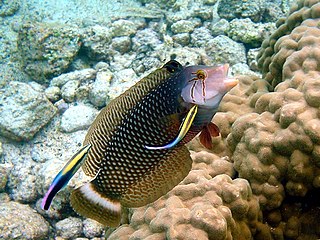
Novaculichthys taeniourus, also known as the rockmover wrasse, carpet wrasse, dragon wrasse, bar-cheeked wrasse, olive-scribbled wrasse or reindeer wrasse, is a species of wrasse mainly found in coral reefs and lagoons in the Indo-Pacific region. These include habitats in the Gulf of California to Panama; tropical Pacific Ocean islands including Hawaii; the Philippines, Indonesia and Australia; and the Indian Ocean to the east coast of Africa. The common name, "rockmover wrasse", comes from their behavior of upending small stones and reef fragments in search of prey. This species is the only known member of its genus.

Jansen's wrasse is a species of ray-finned fish, a wrasse from the family Labridae which is native to the Indian Ocean and Pacific Ocean. In the south-western Pacific Ocean it is replaced by sibling species black-barred wrasse. It can be found in the aquarium trade.
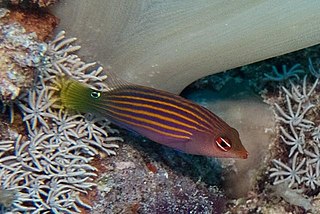
The six-line wrasse is a species of marine ray-finned fish from the family Labridae which has a wide Indo-Pacific distribution. This species is associated with coral reefs and can be found in the aquarium trade.

The slingjaw wrasse is a species of wrasse from the family Labridae which is native to the tropical waters of the Indo-Pacific where it occurs around coral reefs. This species is of minor importance to local commercial fisheries and can be found in the aquarium trade. Relatively mundane at first glance, this fish is notable for its highly protrusible jaws.
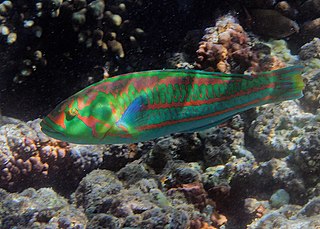
The surge wrasse, also known as the green-blocked wrasse, purple wrasse or red and green wrasse, is a species of wrasse native to the southeast Atlantic Ocean through the Indian and Pacific Oceans, where it inhabits reefs and rocky coastlines in areas of heavy wave action at depths from the surface to 10 m (33 ft). This species is of minor importance to local commercial fisheries, is popular as a game fish, and can be found in the aquarium trade.

The roving coral grouper, also known as the spotted coral grouper, is a species of marine ray-finned fish, a grouper from the subfamily Epinephelinae which is part of the family Serranidae, which also includes the anthias and sea basses. It is found in the Indo-Pacific, although the Red Sea taxon, P. marisrubri, is regarded as a separate species by some authorities.
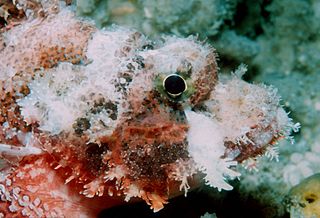
The barchin scorpionfish is a species of marine ray-finned fish belonging to the family Scorpaenidae, the scorpionfishes. It comes from the Indo-Pacific. The species is commonly seen in areas with mixed sand and rubble in reef flats, shallow lagoons, and channels.

The dark-banded fusilier, also known as blue-streak fusilier, bluedash fusilier, or neon fusilier, is a species of marine ray-finned fish, a fusilier belonging to the family Caesionidae. It has a wide Indo-West Pacific range. It is of some importance to fisheries within its range.

The tubelip wrasse is a species of wrasse native to the Indian Ocean and the western Pacific Ocean. This species occurs in lagoons and on coral reefs at depths from 0 to 20 m. This species grows to 17.5 cm (6.9 in) in total length. It is of minor importance to local commercial fisheries and can be found in the aquarium trade. This species is the only known member of its genus.
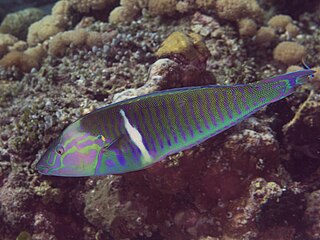
Hologymnosus doliatus, commonly called Pastel ringwrasse , is a marine ray-finned fish belonging to the family Labridae, the wrasses, which is found in the Indo-Pacific area.

Iniistius pavo, the peacock wrasse or blue razorfish, is a species of marine ray-finned fish from the family Labridae, the wrasses, which has a wide Indo-Pacific distribution.
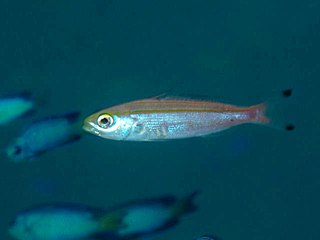
Pterocaesio marri, Marr's fusilier, bigtail fusilier, blacktip fusilier, bananafish or twinstripe fusilier is a species of marine ray-finned fish, a fusilier belonging to the family Caesionidae. It is widespread around reefs in the Indo-West Pacific region.

Halichoeres richmondi, commonly called the Richmond's wrasse or chain-lined wrasse, is a fish species in the wrasse family native from the central Indo-Pacific.

Cymolutes torquatus, the finescale razorfish, razor wrasse or collared knifefish, is a species of marine ray-finned fish from the family Labridae, the wrasses. It is a solitary wrasse of sandy flats which has a wide Indo-Pacific distribution. It has no recorded human uses.

Latent sling-jaw wrasse is a species of ray-finned fish from the wrasse Family Labridae which is associated with reefs in the south-western Pacific Ocean.
Hologymnosus longipes, the sidespot longface wrasse or the plain slender wrasse, is a species of marine ray-finned fish from the family Labridae, the wrasses. It occurs in the western Pacific Ocean.

Pseudocoris heteroptera, the torpedo wrasse or zebra wrasse, is a species of marine ray-finned fish, a wrasse from the family Labridae. It is found in the western Pacific Ocean where it is associated with reefs.
Pseudojuloides cerasinus, the smalltail wrasse or the pencil wrasse, is a species of marine ray-finned fish, a wrasse from the family Labridae. It is found in the tropical Pacific Ocean and was previously considered to have a much wider distribution but the recognition of new species has reduced this wide range.

Stethojulis strigiventer, also known as the three-ribbon wrasse, silverstreak wrasse, silverbelly wrasse, lined rainbowfish or silver-streaked rainbowfish, is a species of marine ray-finned fish, a wrasse from the family Labridae. This species occurs in beds of seagrass and areas of inner reefs and shallow lagoons where there is a substrate consisting of mixed sand, rubble, and algae. It is found in small groups which swim over large areas down as deep as 20 metres (66 ft). The range of this species extends from the Red Sea southwards along the eastern coast of Africa to Algoa Bay in KwaZulu-Natal, South Africa and eastwards to the Marshall and Tuamotu islands, it also extends north to Honshu and south to New South Wales. This species was first formally described as Julis strigiventer in 1833 by the English zoologist Edward Turner Bennett (1797-1836) with the type locality given as Mauritius. When Albert Günther created the genus Stethojulis he designated Julis strigiventer as the type species.



















